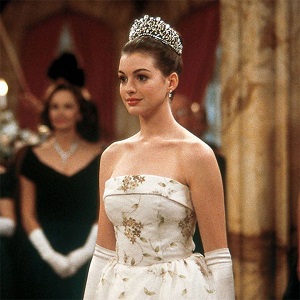
About the Book
-
Author:
- Kathryn Lasky
Cover Story: Elephant in the Room
BFF Charm: Yay!
Talky Talk: Dear Diary
Bonus Factors: Moghul Empire, Being a Princess
Anti-Bonus Factor: Being a Princess
Relationship Status: Sisters for Life
The Official FYA Royal Diaries Drinking Game: Updated Edition
Take a sip when:
- There is talk of a betrothal
- The protagonist references the diary concept (i.e. apologizes for not writing often enough, has to find a hiding place for the diary, explains why she’s writing in it to begin with, etc.)
- The protagonist wonders what it would be like to be a “normal girl”
- There’s a ball
- There’s a trip to the marketplace
- Somebody is poisoned or strangled or in some other way Ye Olde Murdered
- You wish you were a princess
Take two sips when:
- The protagonist becomes officially betrothed
- The protagonist suspects someone of reading her diary
- It’s the protagonist’s birthday (or culturally equivalent celebration)
- There’s obvious historical foreshadowing
- You’re really glad you’re NOT a princess
Take a shot when:
- The protagonist gets hitched
- Another Royal Diarist is mentioned*
* One shot per Royal Diarist, not one shot per mention. Elizabeth gets so many mentions in this book, she’s practically a supporting character. (Upcoming Diarist Queen Victoria also gets mentioned in the Historical Notes at the back.)
Cover Story: Elephant in the Room
Good-quality images of Royal Diaries covers are difficult to find online (especially since Scholastic’s series relaunch seems to have stalled out), but I found this image on the illustrator’s website. (Fun fact: the illustrator also designed the Hunger Games covers.) The most important thing this high-def image reveals is that the elephant in the background is smiling. Happy smiling elephants! These are the things I live for. (Seriously, google “happy elephant.” You’re welcome.)
The Deal:
Ever heard of the Taj Mahal? Well, Jahanara hasn’t, because her dad is still drawing up the plans. Janni is the oldest child of her father’s favorite wife; together her parents are the Emperor and Empress of India. Even though her dad is sometimes styled “Emperor of the World,” Jahanara has a close and loving relationship with her family—except lately for her younger brother Aurangzeb, who might be dabbling in religious extremism. When she’s not worried about herself or her loved ones being poisoned (drink!) by an evil step(grand)mother, hanging with her sassy gay eunuch friend, or trying to catch a glimpse of that hunk from the East India Trading Company, Jahanara is coming to terms with her place and power in the world. As Princess of Princeses, Janni must recognize and confront many of the issues that lie at the heart of 17th-century Indian life: Islam vs. Hinduism, luxury vs. poverty, peace vs. war.
BFF Charm: Yay!

This is another one of the Royal Diaries books that I’m experiencing for the first time, and I can only say I wish I’d found Jahanara sooner. Jahanara goes through a lot of rough shizz in this book, but she never wavers in her curious and empathetic nature. The moments when she is unkind or frivolous make her all the more relatable (and remind me of how wonderful the “diary novel” format is at conveying character). Janni worries that she is “sinless and boring,” but I found her neither.
Swoonworthy Scale: 2, With a Side of Heartbreak
Unlike practically every other Royal Diarist, Janni isn’t expected to get married: in fact, she’s not allowed to. As a female member of the royal family, Janni is hidden away from all men who aren’t members of her family, eunuchs, or blind. Hilariously and heartbreakingly, Jahanara doesn’t even know what “flirting” is. Which means that when she gets the chance to participate in a Flirting Bazaar (yes), even a moment where an attractive Englishman may or may not have caught a glimpse of her cheek is enough to feel pretty swoony.
Talky Talk: Dear Diary
As per uhze*, Kathryn Lasky knocks it out of the park. This is one of those Royal Diaries books that take place over several years, meaning Jahanara occasionally takes months-long breaks from writing. Part of me felt cheated; I would’ve gladly read a book twice the length with all those “missing entries” filled in!
* I agonize daily over the best way to spell the respective abbreviations of “usually” and “casually”; this works, right?
Bonus Factor: Moghul Empire
The luxury! The splendor! The artistry! I knew very little about pre-British empire Indian history before reading this book, and like any well-written piece of historical fiction, it made me want to learn more. It also made me want to be there. Floating in a jewel-encrusted pool in your own private palace, eating flavored ice, being fanned with peacock feathers by servants? Yes please. Which brings us to…
Bonus Factor: Being a Princess

Okay, yes, at this point I am just blatantly ripping off my own post about Marie Antoinette. But what I said about that 18th-century French princess applies just as well (if not better) to this 17th-century Indian princess. The Moghul court might even surpass the French in terms of extravagance: the characters in this book do a lot of casual precious gemstone gift-giving. Jahanara has, yes, her own private palace within the larger court palace. Marie Antoinette liked to dress “down” and pretend she was a shepherdess; Jahanara gets to pretend she’s a market-woman. Needless to say, Janni is waited on hand-and-foot—in fact, servants aren’t even allowed to touch her. Which brings us to…
Anti-Bonus Factor: Being a Princess

Nobody’s allowed to touch her. 🙁 Doctors aren’t even allowed to look at her, which makes recovering from illness a dicey process, at best. Marie Antoinette had the problem of always being on display; for Jahanara, it’s the opposite. She spends her life behind latticed screens which hide her from the world to preserve her “purity.” When she or the other ladies of the harem emerge from these screens, they must wear heavy veils to conceal their faces. Luckily, Janni has the other women of the harem—her mother, her father’s other wives, even her miniature portrait of Queen Elizabeth of England—to remind her that while women in this court may be invisible, they are not always powerless.
Relationship Status: Sisters for Life
Ladies loving ladies is a crucial component of this book, and I am so down to sign up for the harem. This book fascinated me with stories I’d never heard before in a setting which I knew nothing about, and then it broke my heart in an all-too-familiar way. As soon as this book sends me its address, I’m gonna start mailing it pants.
FTC Full Disclosure: I purchased this book with my allowance. Jahanara: Princess of Princesses has been available for years, y’all. So get on that.
About the Contributor:
Maria Greer is originally from Montana but goes to school in the Bay Area, where she totally fails to take advantage of the tech industry. Instead, she is majoring in history and creative writing, with which she plans to do…something. Currently her hope is that someone will come along and offer to pay her to read YA novels and eat cupcakes. Until that day, Maria spends most of her time studying and petitioning the university to let her keep a cat in her dorm.